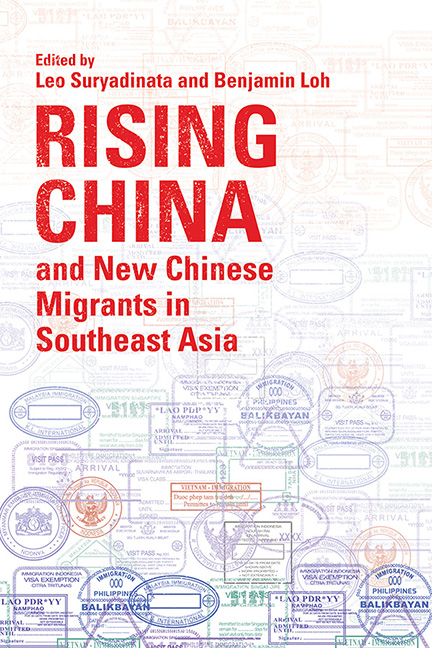Book contents
- Frontmatter
- Contents
- About the Contributors
- Introduction: Rising China and New Chinese Migrants in Southeast Asia
- Part I General Overviews on Rising China and Xin Yimin
- Part II China’s Soft Power, Xin Yimin and Local Communities
- Part III New Chinese Migrants and Local Communities
- Part IV New Chinese Migrants and Local Economies
- Index
15 - ‘Old’ and ‘New’ Chinese Business in Cambodia’s Capital
Published online by Cambridge University Press: 09 January 2024
- Frontmatter
- Contents
- About the Contributors
- Introduction: Rising China and New Chinese Migrants in Southeast Asia
- Part I General Overviews on Rising China and Xin Yimin
- Part II China’s Soft Power, Xin Yimin and Local Communities
- Part III New Chinese Migrants and Local Communities
- Part IV New Chinese Migrants and Local Economies
- Index
Summary
Ever since Hun Sen’s state visit to Beijing in 1996, ties between Cambodia and China—or more accurately, between Hun Sen’s ruling Cambodian People’s Party (CPP) and the Chinese Communist Party (CCP)—have only grown stronger. The state visit was a watershed moment. The Chinese had supported the Khmer Rouge regime (1975–78), while Hun Sen came to power under the auspices of China’s rival, the Vietnamese, who had pushed the Khmer Rouge forces towards the Thai border, and founded the People’s Republic of Kampuchea (PRK) (1979–89). The 1996 state visit not only signalled a rapprochement between China and Cambodia, but also China’s confidence that Hun Sen was Cambodia’s strongman in the making. The Chinese had invited Hun Sen but not Prince Rannaridh, whose Front Uni National pour un Cambodge Indépendant, Neutre, Pacifique, et Coopératif (FUNCINPEC) had formed an unstable coalition government with the CPP after the 1993 elections organized by the United Nations Transitional Authority in Cambodia (UNTAC). Perhaps encouraged by China’s backing, Hun Sen ousted Rannaridh in a coup de force in 1997. In June 2016, roughly two decades after Hun Sen’s state visit and around US$3 billion in Chinese loans and grants later (Veasna 2016), warm ties were once again reaffirmed. Reportedly, as it had done in 2012, Cambodia demanded that ASEAN tone down its statement on China’s disputed claim over the South China Sea, and a few days later China pledged another US$600 million in loans and grants (Hutt 2016a).
Political interdependencies have emerged alongside the influx of Chinese investments, businesses and economic migrants since the 1990s. Cambodia’s infrastructural development, including the construction of bridges, roads and hydropower dams, is largely undertaken by Chinese state-owned companies and financed by Chinese banks (Sullivan 2011). The majority of Cambodia’s garment factories, which account for over three quarters of total exports, are owned and managed by Chinese from ‘Greater China’ (i.e., mainland China, Hong Kong, Taiwan and Macau) (Ear 2016). China is the biggest investor in Cambodia, adding nearly US$5.3 billion between 2013 and 2017 (Hin 2019), and Chinese firms currently hold over forty Economic Land Concessions (ELCs) allocated for tourism development or the cultivation of crops such as rubber, sugar and cassava (LICADHO 2019).
- Type
- Chapter
- Information
- Rising China and New Chinese Migrants in Southeast Asia , pp. 293 - 321Publisher: ISEAS–Yusof Ishak InstitutePrint publication year: 2022



